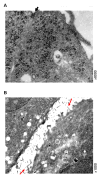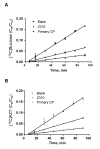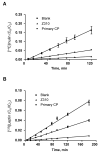Use of Z310 cells as an in vitro blood-cerebrospinal fluid barrier model: tight junction proteins and transport properties
- PMID: 17825520
- PMCID: PMC2677988
- DOI: 10.1016/j.tiv.2007.07.007
Use of Z310 cells as an in vitro blood-cerebrospinal fluid barrier model: tight junction proteins and transport properties
Abstract
Immortalized rat choroidal epithelial Z310 cells have the potential to become an in vitro model for studying transport of materials at blood-cerebrospinal fluid barrier (BCB) (Shi and Zheng, 2005) [Shi, L.Z., Zheng, W., 2005. Establishment of an in vitro brain barrier epithelial transport system for pharmacological and toxicological study. Brain Research 1057, 37-48]. This study was designed to demonstrate the presence of tight junction properties in Z310 cells and the functionality of Z310 monolayer in transport of selected model compounds. Western blot analyses revealed the presence of claudin-1, ZO-1, and occludin in Z310 cells. Transmission electron microscopy showed a "tight junction" type of structure in the sub-apical lateral membranes between adjacent Z310 cells. Real-time RT-PCR revealed that Z310 cells expressed representative transporters such as DMT1, MTP1, TfR, p-glycoprotein, ATP7A, ZnT1, ABCC1, Oat3, OCT1 and OB-Ra. Moreover, Z310 cells cultured in a two-chamber Transwell device possessed the ability to transport zidovudine (anionic drug), thyroxine (hormone), thymidine (nucleoside), and leptin (large polypeptide) with kinetic properties similar to those obtained from the in vitro model based on primary culture of choroidal epithelial cells. Taken together, these data indicate that the Z310 BCB model expresses major tight junction proteins and forms a tight barrier in vitro. The model also exhibits the ability to transport substances of various categories across the barrier.
Figures





Similar articles
-
Establishment of an in vitro brain barrier epithelial transport system for pharmacological and toxicological study.Brain Res. 2005 Sep 28;1057(1-2):37-48. doi: 10.1016/j.brainres.2005.07.046. Brain Res. 2005. PMID: 16126179 Free PMC article.
-
Early lead exposure increases the leakage of the blood-cerebrospinal fluid barrier, in vitro.Hum Exp Toxicol. 2007 Mar;26(3):159-67. doi: 10.1177/0960327107070560. Hum Exp Toxicol. 2007. PMID: 17439918 Free PMC article.
-
[The role of Nrf2 in the alteration of tight junction protein expression in choroid plexus epithelial cells created by lanthanum-activated MMP9].Zhonghua Lao Dong Wei Sheng Zhi Ye Bing Za Zhi. 2023 Jan 20;41(1):2-7. doi: 10.3760/cma.j.cn121094-20220121-00039. Zhonghua Lao Dong Wei Sheng Zhi Ye Bing Za Zhi. 2023. PMID: 36725287 Chinese.
-
Usefulness and limitation of primary cultured porcine choroid plexus epithelial cells as an in vitro model to study drug transport at the blood-CSF barrier.Adv Drug Deliv Rev. 2004 Oct 14;56(12):1859-73. doi: 10.1016/j.addr.2004.07.012. Adv Drug Deliv Rev. 2004. PMID: 15381337 Review.
-
A new in vitro model for blood-cerebrospinal fluid barrier transport studies: an immortalized choroid plexus epithelial cell line derived from the tsA58 SV40 large T-antigen gene transgenic rat.Adv Drug Deliv Rev. 2004 Oct 14;56(12):1875-85. doi: 10.1016/j.addr.2004.07.013. Adv Drug Deliv Rev. 2004. PMID: 15381338 Review.
Cited by
-
Modeling immune functions of the mouse blood-cerebrospinal fluid barrier in vitro: primary rather than immortalized mouse choroid plexus epithelial cells are suited to study immune cell migration across this brain barrier.Fluids Barriers CNS. 2016 Jan 29;13:2. doi: 10.1186/s12987-016-0027-0. Fluids Barriers CNS. 2016. PMID: 26833402 Free PMC article.
-
Parenteral high‑dose ascorbate - A possible approach for the treatment of glioblastoma (Review).Int J Oncol. 2021 Jun;58(6):35. doi: 10.3892/ijo.2021.5215. Epub 2021 May 6. Int J Oncol. 2021. PMID: 33955499 Free PMC article. Review.
-
Characterization of immortalized choroid plexus epithelial cell lines for studies of transport processes across the blood-cerebrospinal fluid barrier.Cerebrospinal Fluid Res. 2010 Aug 12;7:11. doi: 10.1186/1743-8454-7-11. Cerebrospinal Fluid Res. 2010. PMID: 20704740 Free PMC article.
-
Culture of choroid plexus epithelial cells and in vitro model of blood-CSF barrier.Methods Mol Biol. 2013;945:13-29. doi: 10.1007/978-1-62703-125-7_2. Methods Mol Biol. 2013. PMID: 23097098 Free PMC article.
-
Involvement of CTR1 and ATP7A in lead (Pb)-induced copper (Cu) accumulation in choroidal epithelial cells.Toxicol Lett. 2014 Feb 10;225(1):110-8. doi: 10.1016/j.toxlet.2013.11.034. Epub 2013 Dec 6. Toxicol Lett. 2014. PMID: 24316150 Free PMC article.
References
-
- Bjorbaek C, Elmquist JK, Michl P, Ahima RS, van Bueren A, McCall AL, Flier JS. Expression of leptin receptor isoforms in rat brain microvessels. Endocrinology. 1998;139:3485–3491. - PubMed
-
- Dehouck MP, Jolliet-Riant P, Bree F, Fruchart JC, Cecchelli R, Tillement JP. Drug transfer across the blood– brain barrier: correlation between in vitro and in vivo models. Journal of Neurochemistry. 1992;58:1790–1797. - PubMed
-
- Dratman MB, Crutchfield FL, Schoenhoff MB. Transport of iodothyronines from bloodstream to brain: contributions by blood:brain and choroid plexus:cerebrospinal fluid barriers. Brain Research. 1991;554:229–236. - PubMed
Publication types
MeSH terms
Substances
Grants and funding
LinkOut - more resources
Full Text Sources
Other Literature Sources
Medical
Research Materials
Miscellaneous

